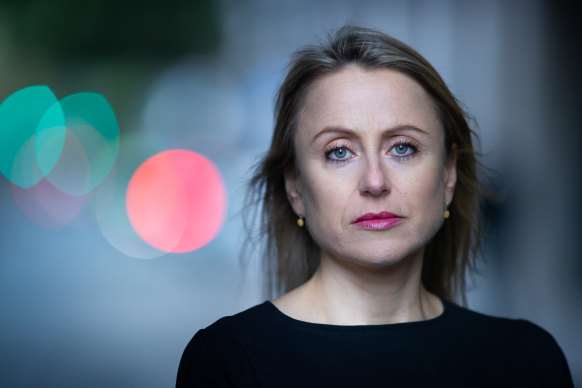This was published 10 months ago
Violent porn, online misogyny driving gendered violence, say experts
By Jordan Baker and Amber Schultz
The NSW Women’s Safety Commissioner, Hannah Tonkin, has warned easy access to pornography and extreme online misogyny were fuelling harmful attitudes to relationships as she called on men to lead cultural change by stepping up as leaders and role models.
As new statistics laid bare the domestic violence crisis in NSW, where police are called to more than 500 incidents a day, academics and experts raised concerns that vitriol against women online was contributing to sexualised violence and misogyny, especially among younger men.
So far this year, 26 Australian women have been murdered. Nine of the alleged perpetrators were under 30.
“It’s shocking and it’s heartbreaking,” said Tonkin. “Women are feeling angry, they’re feeling unsafe. And we need to come together as a nation, urgently, to address this.”

NSW Women’s Safety Commissioner Hannah Tonkin Credit: Simon Schluter
The dead include mother and childcare worker Molly Ticehurst, whose alleged killer, Daniel Billings, 29, was released on bail after being charged with sexually assaulting and intimidating her less than two weeks before she died.
Her death has sparked widespread community outrage, and prompted calls for a state royal commission into domestic violence.
New data shows NSW Police were called to more than 500 domestic violence incidents every day last year, and at almost half of them there was a child at risk of harm. It took an average of 26 incidents for a victim to make a report.
In the past two years, domestic violence assaults reported by NSW Police have increased by 6.7 per cent, while intimidation, stalking and harassment reports have increased by 6.1 per cent, Bureau of Crime Statistics and Research figures show.
Tonkin said efforts to reform police, justice and welfare responses must be accelerated, but cultural change was needed at the same time. She was concerned about the material young men and boys were accessing online, with some boys watching pornography from the age of 11 or 12.
“We’re seeing a generation of young men who are growing up with very early and easy access to pornography,” she said. “They’re also bombarded by quite extreme misogyny online.
“When boys and young men use social media, there are algorithms that push out problematic messages about women and what it means to be a man. And this is all happening at a crucial time in their lives when boys and young men are developing attitudes about relationships and gender roles.”
Tonkin said men had a key role to play.
“They need to step up to be leaders on these issues, and they need to be modelling respectful relationships and talking about respect and healthy models of masculinity, particularly to their sons,” she said.
Our Watch CEO Patty Kinnersly held serious concerns about the influence of the online environment on young people, warning sexist rhetoric by public figures, coupled with violent pornography, could lead to sexualised violence.
“The agitating effect of the online environment is much broader than advertised, and the way it’s shaping ideas about how young men engage with women is absolutely problematic,” she said.
A 2019 global masculinity survey found almost 5 per cent of Australian men did not agree that women deserved equal rights to men, and a third felt women’s rights had gone too far; men aged 18 to 35 were more likely to hold that view than those aged over 55.
A survey by men’s mental health charity Man Cave found 92 per cent of Australian high-school-aged boys had heard of self-proclaimed misogynist Andrew Tate, while 35 per cent said they “related” to him. Studies have also found that nearly 90 per cent of porn depicts violence against women.
The Man Box 2024 study, led by Professor Michael Flood, found at least a third of Australian men thought a man should have the final say about decisions in their relationship and was entitled to know the whereabouts of his partner.
“It’s very clear that substantial minorities of men and boys believe the things that feed into some men’s domestic and sexual violence,” said Flood, from the Queensland University of Technology.
“The boys and young men who are part of those online communities, it is feeding into a tolerance for violence and sexual violence, it’s seen an upswing in misogyny. We know that that’s a risk factor for violence perpetration.”
Deakin University associate professor Josh Roose said the younger generation of a gendered violence perpetrator is different from the older one.
“The messaging of the abuse and the way it’s framed, the sheer vitriol and the hate in the Facebook and online space. Reaching men in online spaces and also face to face where possible, through peer interventions is critical,” he said.
CEO of Rape and Sexual Assault Research and Advocacy Dr Rachael Burgin said gender inequality was a direct driver of gendered violence.
“The attitude that women belong in the home … is still prolific in Australia,” she said.
If you or someone you know is affected by sexual assault, domestic or family violence, call 1800RESPECT on 1800 737 732.
The Opinion newsletter is a weekly wrap of views that will challenge, champion and inform your own. Sign up here.
correction
This story originally described Tonkin as the Domestic Violence Commissioner. She is the Women’s Safety Commissioner.